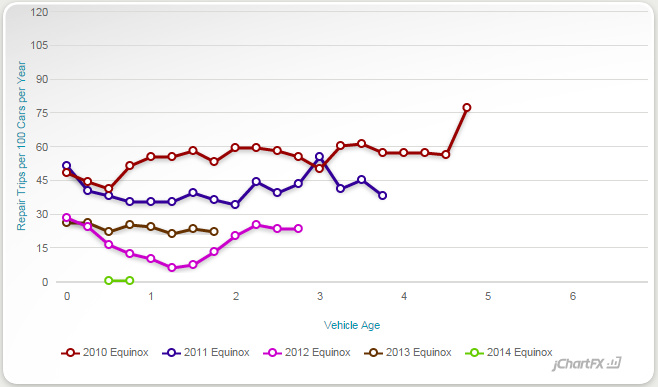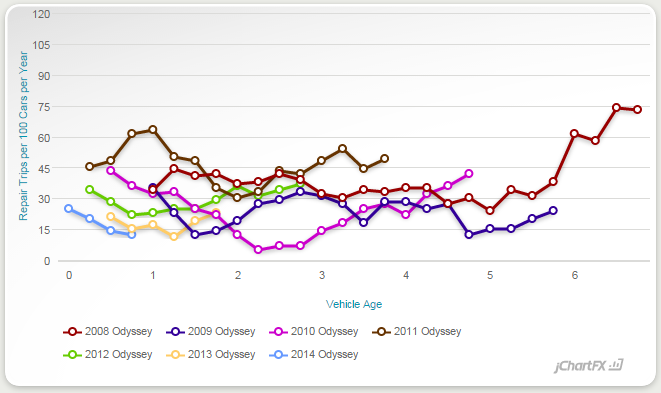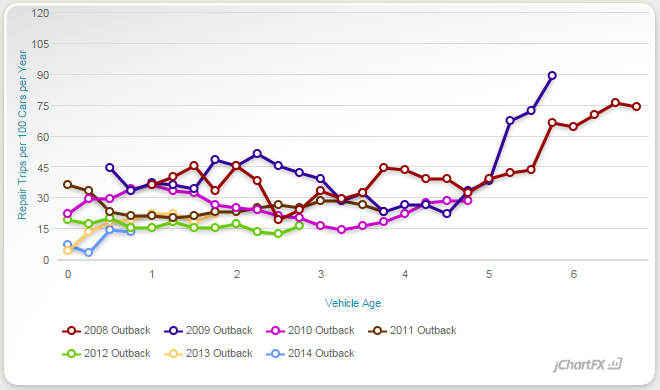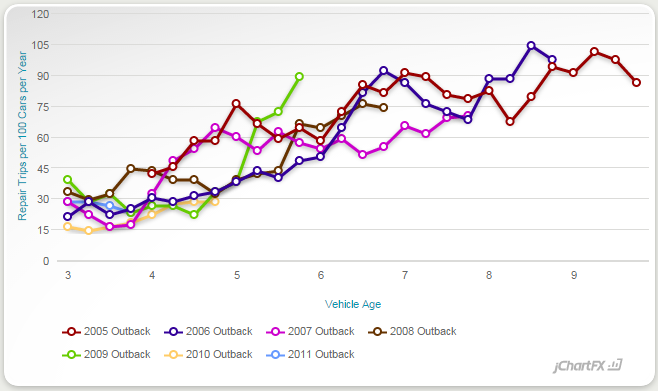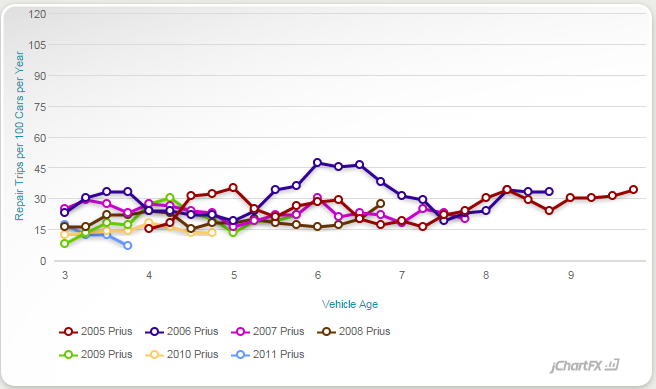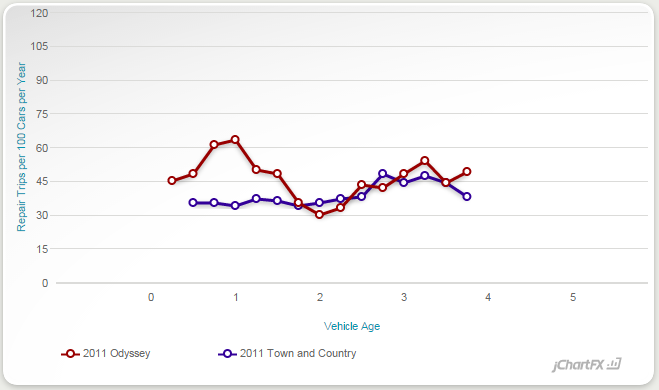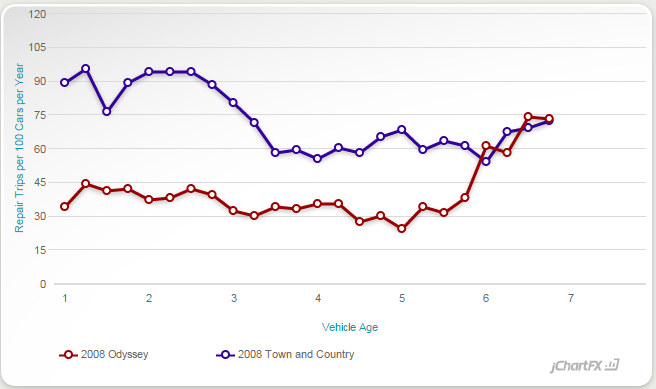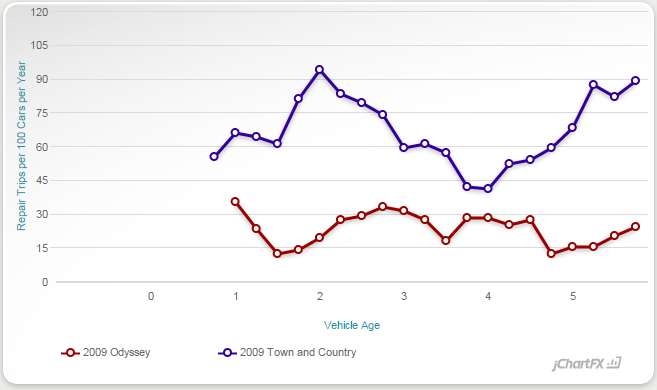Every time we add a new feature, I wish we could have added it earlier (unfortunately, it’s just not possible to do everything immediately). This is especially the case with the latest addition: car reliability trends
We updated our car reliability stats–for the 34th time–at the end of February. Each of the previous 33 times, our stats have only reflected owner experiences over the past year. They’ve been a snapshot in time, or more specifically of one year in time. You could tell how reliable a car had been recently. But was it getting better or worse? And what did previous model years suggest about its future?
To help answer these questions, we’re now doing something that no source of car reliability information has done before: we’re revisiting past results, up to six years of them, and graphing them to potentially answer many different questions:
1. How a particular model year of a model been getting better or worse?
2. How does this car’s reliability as it has aged compare to other model years?
3. How does this car’s reliability as it has aged compare to other models?
First, consider the graph at the top of this post. It displays reliability over the past five years for five model years of the Chevrolet Equinox (and the related GMC Terrain). Reliability for every model year save the 2012, which experienced a fortuitous dip, has been fairly consistent over time. (Well, at least until the 2010 experienced a severe uptick with the latest update. With the next update, in May, we’ll see if this was a random blip or a dramatic turn for the worse.) The other obvious conclusion: General Motors has dramatically improved the reliability of these cars from model year to model year. The 2011 has been quite a bit better than the 2010, the 2012 and 2013 have been quite a bit better than the 2011, and the 2014 has been extremely reliable so far, with no repairs reported last year.
Continuous improvement is quite common–at least until a car is redesigned. Two cycles of continuous improvement can be discerned in the record of the Honda Odyssey:
The patterns aren’t as clear as they are for the Equinox, but the 2009 and 2010 have usually been more reliable than the 2008, when the Odyssey received some mid-cycle enhancements. But the 2011 has been more troublesome than any of these model years. What happened? The Odyssey was completely redesigned. But Honda then worked the bugs out of the redesigned van, improving it for 2012, then again for 2013 and 2014.
People tend to think of Subaru as a highly reliable brand. And since they were redesigned for 2010 the popular Outback crossoverish wagon and related Legacy sedan have compiled an enviable record:
Notice how much less reliable the previous generation 2008 and 2009 were at the same ages. You might also notice that the 2008 and 2009 have gotten much worse in recent years. Focus on the previous generation cars, a pattern emerges:
Model year after model year, these cars were fairly solid until they turned four. Then various parts started failing, especially wheel bearings and CV joint boots, but also head gaskets. Reliability rankings that placed Subaru near the top? They analyzed only the first three years of ownership.
Will 2010 and newer Subarus similarly take a turn for the worse? Unfortunately, it’s too soon to say. As they near their fifth birthday, the 2010s have gotten a little worse, but remains much more reliable than most earlier model years at this age.
While cars do tend to require more repairs as they age, most do so less dramatically than the Outback. For a car that ages especially well, check the record for the Toyota Prius:
These lines are much more level than the Subaru’s, aren’t they? Even as it nears its tenth birthday, the 2005 Prius requires repairs just a little more often than the average new car. Notice a bump in the 2006’s trend line? I think that’s when many of that year were having problems with their xenon headlights. A single common problem will often produce a bump like this, or even a much larger one.
It’s also possible to compare reliability trend lines for two models. The Honda Odyssey has a stronger reputation than the Chrysler Town & Country. But compare 2011s, and the Honda’s reliability advantage is far from obvious:
But, if you’ve been paying close attention, you might remember something about the 2011 Odyssey: it was an all-new design. The Chrysler was also updated for 2011, but less extensively. Also, these minivans aren’t that old, and Hondas (like Toyotas) tend to have their largest advantage in reliability when older. So, let’s take a look at the 2008s:
Oops, I did it again, just in the opposite direction. For 2008 Honda updated its minivan, but Chrysler totally redesigned the Town & Country. And yet, after years during which the Honda had a huge advantage, the two have been about equally troublesome lately. Let’s try this one more time, with 2009s:
Now there’s the difference we initially expected. But it’s much less clear with many other years. In many cases the Chrysler minivan has been considerably less reliable than the Honda Odyssey at many points in their lives, but at others they’ve been about even. It pays to dig into the specifics. Take a swing at it–select “reliability trends” in the first box–and post a comment if you find anything interesting:
